November itinerary in Japan Day 3 (Fukuoka Day 1 Meal edition)
(Wednesday, November 17)
Table of contents
1. Breakfast
When I was heading to Tosu Station from Sasebo Station on the JR Limited Express Midori No. 6, I ate the bacon egg cheeseburger I bought at the station convenience store “Family Mart”. Actually, I wanted to buy ekiben, but I couldn’t because the store selling ekiben at Sasebo Station wasn’t open. For those who depart early in the morning, I would like the ekiben shop to sell ekiben from early morning.
The bacon egg cheeseburger I ate for breakfast is a hamburger with the same ingredients as the Sasebo burger “Special Burger” Yen 880 (tax included) that I ate at Big Man the day before. Of course, Big Man’s “special burger” was more delicious, but the bacon egg cheeseburger of the convenience store was delicious enough considering the price (Yen 348 tax included). The deliciousness of convenience store food is rediscovered like the “Turkish rice” of the convenience store I ate on the first day .
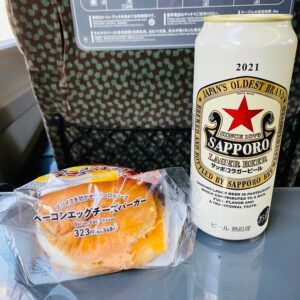
The beer I drank when eating the bacon egg cheeseburger was my favorite Sapporo beer “Akaboshi”. As introduced in the Tohoku / Hokkaido Travel Edition, “Akaboshi” is the oldest beer brand in Japan released by Sapporo Beer’s predecessor, Kaitakushi Brewery, in 1877. I didn’t have to drink the northernmost Hokkaido beer in Sasebo, the westernmost part of Japan, but I couldn’t help because the craft beer in Nagasaki wasn’t on sale.
In fact, Nagasaki Prefecture has almost no production of craft beer, and there is only a craft beer brewery called “ISLAND BREWERY” on Iki Island. Moreover, “ISLAND BREWERY” was just created in May 2021.
By the way, according to a survey by the National Tax Agency, the per capita beer consumption in Nagasaki Prefecture in 2019 is 18.6 liters, which is 13% lower than the national average of 21.5 liters. On the other hand, the per capita consumption of shochu in Nagasaki Prefecture is 9.1 liters, which is 25% higher than the national average of 7.3 liters. Kagoshima Prefecture, which is a large-scale production area for shochu (beer consumption per capita is 33% lower than the national average, but per capita shochu consumption is 3.9 times the national average), is extremely fond of shochu. Although not as much as Kagoshima prefecture, Nagasaki prefecture is also Kyushu, so I tend to like shochu rather than beer.
2. Kurume Ramen Road “Menshi”
After visiting the Arima family Mausoleum, I took a bus from JR Kurume Station to Nishitetsu Kurume Station and ate Kurume ramen at “Menshi“. In Kurume City, Nishitetsu Kurume Station and JR Kurume Station are 2.2km apart, and it takes about 30 minutes on foot. There are about 4 buses per hour, and the fare is Yen 170.
Restaurants are concentrated on the Nishitetsu Kurume Station side, and there are only a few around JR Kurume Station. Nishitetsu Kurume Station is more convenient than JR Kurume Station because it has a direct train to Hakata Tenjin Station, which is the largest downtown area in Fukuoka. In fact, the number of passengers getting on and off at Nishitetsu Kurume Station is overwhelming at 24,321 (FY2020), which is 4.5 times that of JR Kurume Station where the Shinkansen stops.
I ordered a lunch set (Ramen Kokorozashi and Kurume Darum Don) at “Menshi”. There are two types of ramen in “Menshi”, “Ramen Kokorozashi” (rich taste) and “Ramen Michi” (light taste). It is difficult to explain the taste of the “Ramen Kokorozashi” I ate, but I was impressed by the surprising taste. It was delicious enough to be in the top 5 of the Tonkotsu (pork bone) ramen I had eaten in the past. The staffs of ramen shop were also cheerful and pleasant to serve customers. The store was always full.

I didn’t know until I went to Kurume, but Kurume is the birthplace of tonkotsu ramen. The first tonkotsu ramen was devised by Tokio Miyamoto, the first manager of the ramen shop “Nankin Senryo” in 1937, by fusing Champon in Nagasaki Prefecture, where he was born, with Chinese noodles in Yokohama. The difference is that Kurume ramen is a way to add soup when the soup is low, while Hakata ramen is a method of making just the amount of soup used that day. Kurume ramen is basically not fat, so it is relatively light.
At present, Hakata ramen is overwhelmingly more popular nationwide than Kurume ramen. It is a form in which a large city called Hakata (Fukuoka City) takes in the specialties of neighboring mid-sized cities and makes them their own specialties. I think this has a similar relationship to Takoyaki in Osaka Prefecture, which takes Akashiyaki in Akashi City, Hyogo Prefecture. I would like the original Kurume ramen and Akashiyaki to become more well known.
Kurume Darum Don is a white offal bowl. The name “Darum” seems to have started when medical students called the intestine Darm (German) in medical terms. It is said that after World War II, Darum began to serve workers with cheap and delicious foods and pork hormones as Yakitori. By the way, Kurume City has the highest number of doctors per 100,000 population among government-designated cities and core cities nationwide. “Darum” is the name given to Kurume, the city of doctors. In German, the heart is called Herz (Heart), and Herz is also used in Kurume’s grilled menu.

Kurume’s Yakitori is characterized by its versatility, such as chicken, pork, beef, fish and shellfish, and vegetables, which can be used as ingredients other than chicken. Kurume is the city with the largest number of Yakitori shops per capita in Japan, and the town information magazine of Kurume declares that “the King of Yakitori town in Japan”. I didn’t have time to eat this time, but when I visit Kurume next time, I would like to eat grilled chicken as well.
Kurume is the place where Bridgestone was founded. Therefore, there are many factory workers in the rubber industry and tire industry in Kurume, and the number of yakitori shops has increased in order to provide workers with cheap and delicious food. This is different from the recent trend of forcibly making local gourmet food for town revitalization. Therefore, I like Kurume’s Yakitori as a naturally rooted local food.
It’s different from the story of food, but Kurume is famous as the birthplace of Checkers. A poster for a concert by former Checkers vocalist Fumiya Fujii was posted in front of Nishitetsu Kurume Station, but it was sold out. It’s really popular.
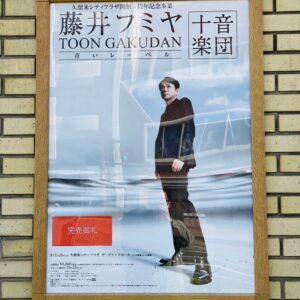
3. Furo Chaya (teahouse)
At the “Furo Chaya (teahouse)” in Tenmangu, Dazaifu, I had a set of Umegae Mochi, a specialty of Dazaifu, and matcha (Yen 600 tax included). I have been to Dazaifu Tenmangu several times, but I ate Umegae Mochi for the first time. On the 17th of every month, “Furo Chaya” offers Umegae Mochi made from ancient rice, and I was able to eat the rare Umegae Mochi. It was a delicious freshly baked mochi that goes very well with matcha.
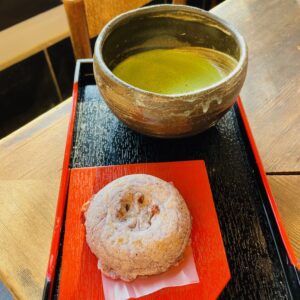
Umegae Mochi is said to have originated from the fact that when Sugawara no Michizane was under house arrest, an old woman inserted a mochi stabbed into the tip of a plum branch through the lattice in the room, but there are various theories. However, like the origin of this Umegae Mochi, Umegae Mochi does not use plums and does not have the scent of plums. The part where the ume stamp is placed is the relationship between the mochi and the plum.
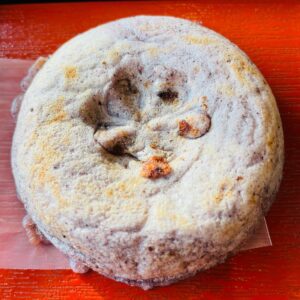
4. Motsunabe “Miyamoto”
For dinner, I ate a motsunabe with a friend from college at “Miyamoto“, near Gion Station in Fukuoka City. It is a long-established popular store founded in 1974, which was also published in the 2019 Michelin Guidebook Fukuoka.
The characteristic of Miyamoto’s motsunabe is that they serve the first motsunabe with only beef offal and garlic. From the owner’s desire to simply taste the deliciousness of beef offal that has been prepared for 4 hours, a motsunabe of beef offal and garlic chives is provided. This simple motsunabe is delicious because of the owner’s commitment. Later, we added tofu and cabbage, but I felt that the simple motsunabe with beef offal and garlic was more delicious.
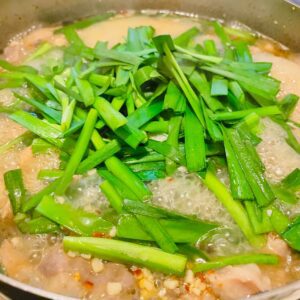
In addition, the motsunabe of “Miyamoto” has a strong soy sauce flavor that goes well with sake. We were drinking more and more and we drank more than usual.
The inside of the store had a taste like a long-established store, and it was a cozy store. Recently, the number of beautiful and fashionable motsunabe shops has increased, but I would like to see some long-established shops such as “Miyamoto” that retain the atmosphere of the Showa period. “Miyamoto” seems to be a popular shop for Hakata people, and the day we visited was full. It became a shop I would like to visit again when I visited Hakata.
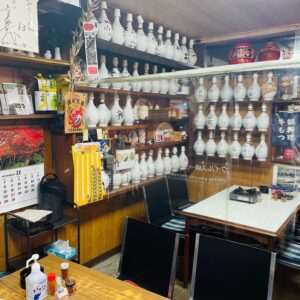
Note: The departure / arrival times, fares, admission fees, meal fees, etc. of transportation listed in the text are as of the time of writing the BLOG. Please check for yourself when you go on a trip as it may change in the future.
